How to Create a 4 Axis Rotary Feature
Introduction
This tutorial explains how to create a 4-Axis Rotary feature. You learn how the toolpath is applied to the part geometry, how to limit the toolpath along the rotary axis, how to create multiple depths (offset from the geometry), and how to use the Cut Interval to plunge at a specific location on the part. You also learn how to set the Base Point and Direction to define the rotary axis of the part and create the proper toolpath based on the machining origin. Finally, you learn how to set the Work Offset shift values to properly align the part on the machine for posting and simulation.
Example File
The SolidWorks part file for this tutorial is available for download at: http://www.bobcad.com/helpfiles. If you are connected to the Internet, you can click the link provided to download and save the 4 Axis Rotary Example 1.SLDPRTzip file. After downloading and extracting the zip file, you can then open the example to follow along with this example. In the example file provided, the stock and Machine Setup are already defined for the part. The program is simulated using the BC 4x Mill, which is a 4 axis machine with an A-axis rotary.
Part 1) Add the Feature
-
Open the example file: 4 Axis Rotary Example 1.SLDPRT
-
To insert a 4 Axis Rotary feature, in the Property Manager area, click the
 CAM Tree
tab.
CAM Tree
tab. -
Right-click
 Machine
Setup, and click Mill 4 Axis
Rotary.
Machine
Setup, and click Mill 4 Axis
Rotary.
The 4 Axis Rotary Wizard displays.
Part 2) Select Geometry
-
In the Geometry Selection dialog box, click Select Geometry.
In the ![]() Feature Manager design tree, select
the entire part by clicking Part Model.
Feature Manager design tree, select
the entire part by clicking Part Model.
The geometry changes to the selection color to show that it is selected.
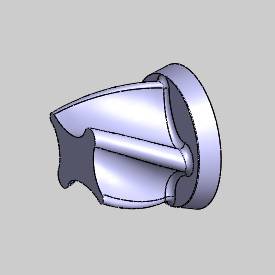
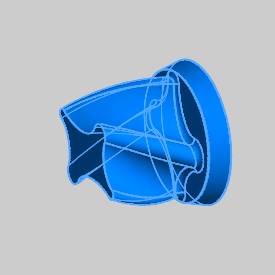
-
To confirm the geometry selection, click
 (OK).
(OK).
The 4 Axis Rotary Wizard displays. -
Click Next>> to finish the Geometry Selection dialog box and begin editing the feature parameters.
Part 3) Define the Feature Parameters
-
In the Feature settings, notice that the Clearance Plane is automatically set using the value from the Machine Setup dialog box.
-
The Rapid Plane is set to 0.200.
-
The Feed Plane is set to 0.100.
-
Notice that the Top of Feature is automatically set (0.000) based on the selected geometry and machining origin.
-
Click Next>> to open the Machining Strategy dialog box.
Part 4) Define the Machining Strategy
-
Confirm that there is one 4 Axis Rotary operation in the Current Operations list.
(You can add one or more 4 Axis Rotary operations to a single feature.) -
No other changes are needed for this example, as only one 4 Axis Rotary operation is needed.
Click Next>> to go to the Posting dialog box.
Part 5) Define the Posting Parameters
-
The Work Offset # is automatically set to the value previously defined in the Machine Setup dialog box.
You can update the Work Offset # for the feature here when you want to change it from the number defined in the Machine Setup. -
Click Next>> to open the Multiaxis Posting dialog box.
Part 6) Define the Multiaxis Posting Parameters
-
Notice, at the top of the dialog box, that the Use Machine Settings check box is selected.
This means that the Multiaxis Posting parameters for the feature use the same parameters as the machine that is selected in Current Settings.
You can clear the Use Machine Settings check box to define the Multiaxis Posting parameters of the feature separately from the current machine settings.
For this example, no changes are needed.
-
Click Next>> to go to the Tool page.
Part 7) Define the Tool Parameters
-
In the Tool Data group, clear the
 System Tool check box.
System Tool check box.
Set the Diameter to 0.500 and the Flute Length to 3.000.
Set the Corner Radius to 0.250 and the Overall Length to 5.000. -
Notice that the tool holder is automatically assigned.
In this example, you modified the tool parameters manually (after you cleared the System Tool check box), which retained the holder assignment of the previous tool.
(You can assign a tool holder to a tool in the Tool Library to use a the default for that tool.) -
To finish the tool definition and go to the Patterns dialog box, click Next>>.
Part 8) The Pattern Dialog Box
-
In the Cut Pattern group, to define one-way cutting, select Zig.
-
Next to Style, click the arrow and select Around.
Important: To create proper toolpaths with the Rotary feature, you must define the Direction and Base Point for the rotational axis of the part. The values used to set the Base Point are based on where the machining origin is located in reference to the center of rotation for the part. If you place the machining origin in-line with the rotary axis, then the Base Point values are set to zero. Placing the machining origin on the rotational axis of the part means there is no difference to report between the machining origin and the rotary axis. In such a scenario, although the Base Point values are zero, the Direction of the rotary axis must still be properly defined.
-
The Rotary Axis must be defined for the part. To set the direction of the rotary axis, in the Rotary Axis group, select X Axis.
Because the machining origin was moved away from the center of rotation, this difference must be defined using the Base Point parameter.
The following image shows the distance that is used to set the base point. This is the distance from (1) the machining origin to (2) the center of rotation of the part.
This parameter is an important part of proper toolpath creation.
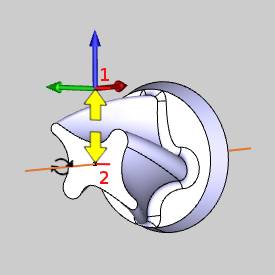
(You can click the ![]() Machine
Setup item in the
Machine
Setup item in the ![]() CAM Tree to
view the machining origin.)
CAM Tree to
view the machining origin.)
-
The only difference to report for this example is along the Z-axis. The radius of the part (and stock) is 3.2679 inches.
In the Base Point group, in the Z box, type -3.2679. -
In the Cut Direction group, select Clockwise.
-
To finish the Patterns dialog box, click Next>>.
Part 9) The Parameters Dialog Box
-
In the Finish group, in the Stepover box, type 0.100.
-
To leave material for finishing, in the AllowanceXYZ box, type 0.050.
-
To calculate the toolpath, click Compute.
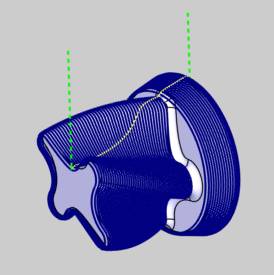
Notice that a single toolpath pass is created, for the entire length of the part, that follows the selected surfaces.
The next step is to edit the feature and use the Along Rotary Axis options to limit the area of the part that is cut.
Part 10) Edit the Feature and Limit the Toolpath
-
When you computed the toolpath, the 4 Axis Rotary feature was added to the CAM Tree.
To edit the feature, in the CAM Tree, right-click Feature4
Axis Rotary, and click Edit.
Feature4
Axis Rotary, and click Edit. -
On the left side of the dialog box, click Parameters.
-
In the Along Rotary Axis group, select the
 End
check box, and type 4.00.
End
check box, and type 4.00.
The toolpath now ends 4 inches from the Machine Setup instead of cutting the entire part.

(You can also limit the toolpath by changing the Start parameter to define where the toolpath starts in relation to the Machine Setup, along the defined Rotary Axis Direction.)
Tip: You can use the Along Rotary Axis parameters Start and End, to define where the toolpath starts and ends. (By default, the Rotary feature creates the toolpath by cutting in the positive direction along the selected rotary axis. For example, with a A-axis rotary (rotation around the X-axis) the toolpath is from left to right.)
-
To add the changes and view the results, click Compute.
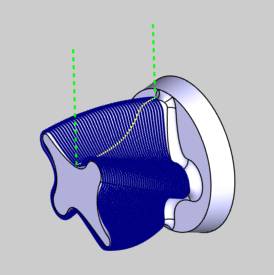
Part 11) Create Multiple Passes
-
The next step is to add multiple passes to the feature.
Edit the feature, and on the left side of the dialog box, click Parameters. -
In the Multiple Passes group, select the
 Multiple
Passes check box to enable the Roughing Passes and Finishing
Passes groups.
Multiple
Passes check box to enable the Roughing Passes and Finishing
Passes groups. -
In the Roughing Passes group, in the Number box, type 2.
In the Spacing box, type 0.250. -
Next to Sort By, click the arrow and select Passes.
This causes the feature to cut each pass before moving on to the next pass. In other words, this cuts the entire part to one depth before moving on to the next depth. -
To view the results, click Compute.
The toolpath now contains two passes instead of the single pass created earlier.
Notice that the multiple passes are created from the selected surface and are layered outward. (They are not layered from the stock inward.)
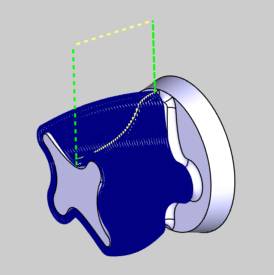

Part 12) Change the Cut Interval
Before simulating the program, there is one last change to make. You can see in the previous step that the tool is plunging, at rapid rate, into one of the deepest areas of the part geometry. The next steps cause the tool to plunge into a much more shallow area of the part.
-
Edit the feature, and click Patterns.
-
In the Angular Start/End group, select the Cut Interval option.
-
In the Angle Start box, type -135.
-
In the Angle End box, type 225.
-
To add the changes and view the result, click Compute.
The result is shown next.
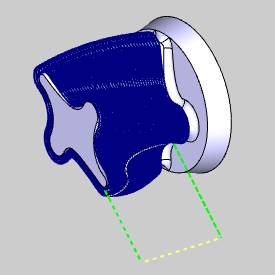

Part 13) Simulate the Program
-
To view the part being cut, in the BobCAM menu, click
 Simulation.
Simulation.
To learn more about using simulation, view the Getting Started with Simulation.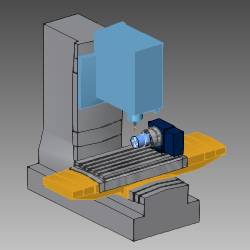
-
For this example, it is important to understand the Work Offset parameter that was previously defined in the Machine Setup.
To open the Machine Setup dialog box, in the CAM Tree, right-click
CAM Tree, right-click  Machine Setup,
and click Edit.
Machine Setup,
and click Edit. -
In the Machine Setup tab, under Work Offset, notice the XYZ values.
These XYZ values represent the distance from the machine zero to the part zero (machining origin) defined in the Machine Setup. For this example, this is from the center of the face of the rotary table (machine zero) to the machining origin that is on the top of the cylindrical stock. -
Again, when the machining origin is not the same as the machine zero, you must define the difference between these two coordinate systems using the Work Offset dialog box. This is necessary to create the proper machine simulation and NC program.
This concludes the tutorial.
